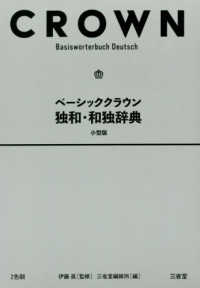- ホーム
- > 洋書
- > ドイツ書
- > Humanities, Arts & Music
- > Music
- > musical equipment
Description
(Short description)
The composition superimposes modern rhythms of South American provenience with European forms and compositional techniques. The combining of the two different worlds of music illuminates the diversity of today's music and its beautiful possibilities on infinite new combinations.Besetzung:4 Gitarren
(Text)
Daniel Schnyders "Music for Four Guitars" reflektiert verschiedene Bereiche der Gitarrenmusik. Die Komposition stellt moderne Rhythmen südamerikanischer Provenienz europäischen Formen und Gestaltungsprinzipien gegenüber. Aus der Wechselwirkung entsteht neue Musik, die zugleich vertraut klingt. Die Verbindung dieser beiden musikalischen Welten zeigt die Verschiedenheit der heutigen Musik und ihrer schier unerschöpflichen Möglichkeiten.Schwierigkeitsgrad: 4-5
(Short description)
The composition superimposes modern rhythms of South American provenience with European forms and compositional techniques. The combining of the two different worlds of music illuminates the diversity of today's music and its beautiful possibilities on infinite new combinations.Besetzung:4 guitars
(Text)
exture. Switching from the strict canon to embellishments creates tension between freedom and the strict hidden order. We know that very well from the music of J.S. Bach or Bela Bartok. 'Fairytale' is the pragmatic juxtaposition of a completely different way of musical thinking. The movement is based on harmonic and rhythmic fundamentals derived from Brazilian music. Basically the four guitars play on three different layers which rhythmically interact with each other: bass melody, rhythm with complimentary rhythm, and melody. For classically trained musicians the hidden African color of the music may be unusual, new and sophisticated. The accents are delayed to the off-beats. 'Fairytale' combines classical and non-European musical influences in a natural and sophisticated way. In spite of the unusual rhythmic approach, the audience will find this dance-like movement very accessible. 'Coding Against Memory' transforms the musical material from the canon, unweiled in the first movement, in a different way. Single elements of the canon have been isolated and consequently alongated, turned upside down, etc. These techniques are very fundamental and essential in the tradition of European art music but not really common in jazz and other non-written music. The third movement relates to movement one and reflects on the European roots and tradition. 'Dancing With My Lady' corresponds with the dance-like African quality of the second movement but with an emphasis on the inexaustible rhythmic vocabulary of South America, especially the energy-giving, high-spirited Samba. The whole piece therefore is written in a loose thematic ABAB form. This work was originally commissioned by the EOS Guitar Quartet and performed in numerous concerts.Instrumentation:4 guitars







